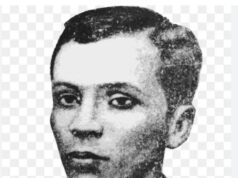The Sideco House used as headquarters of then Pres. Emilio Aguinaldo when he transferred the seat of his revolutionary government to San Isidro, Nueva Ecija on March 31 to May 17, 1899. It is now used as “General Aguinaldo Gospel Center” by a religious group.
CABANATUAN CITY – Every September 2 is Nueva Ecija Day, a non-working holiday.
But it is not the founding anniversary of the province, as is the usual thing whenever such occasion is celebrated, but rather in honor of the Novo Ecijano heroes of the 1896 revolution. A law has been passed for the “Nueva Ecija Day” observance.
“It is in honor of them who earned for Nueva Ecija the honor of being memorialized in the Philippine flag,” said former Rep. Eduardo Nonato Joson of the first district of Nueva Ecija. He introduced a bill that eventually became a law declaring every September 2 as “Araw ng Nueva Ecija.”
The bill which was passed by Congress and the Senate on Sept. 4, 1991 and January 30, 1992, respectively, was signed into law by then Pres. Corazon Aquino on June 2, 1992. “I sought the passage of that law, with the help of then Sen. Alberto Romulo, to become a permanent tribute for the Novo Ecijano heroes who sacrificed for freedom sake that subsequently ensconced our province to a lofty place in history,” Joson said.
Sept. 2, 1896 in the province’s history, he said, was the day the revolutionists rose in arms to lay siege to the provincial capitol and garrison located that time in San Isidro, Nueva Ecija. It happened a few days after the “First Cry of Balintawak” and earned the sobriquet “First Cry of Nueva Ecija”.
Joson introduced the bill that became R.A. 7596 declaring September 2 as “Araw ng Nueva Ecija and a special non-working holiday in the province. This province, declared a “commandancia” (outpost) by the then Spanish Governor-General Fausto Cruzar in 1705 and named after his home province in Spain, remained without a founding anniversary.
“The revolution in Nueva Ecija spawned many heroes and many pillars in the country’s uprising. The Sept. 2, 1896 siege in San Isidro town demonstrated their sheer courage in the face of their superior enemy. Many Novo Ecijanos became martyrs because of that fight for freedom,” Joson said.
An account of that siege published in one of the Nueva Ecija Day programs which was quoted from the manuscript of the late Prof. Leopoldo Serrano, a local historian, indicated that the siege was led by Mariano Llanera, then capitan municipal of Cabiao town, along with Pantaleon Valmonte, capitan municipal of Gapan town.
Though they were officials in the colonial government, they were secret members of the Katipunan. Accompanied by a musikong bumbong (bamboo musical band) later known as Banda Makabayan de Cabiao to disguise the attack, the more than 700 attackers, armed only with a few guns, bolos, and pointed sticks marched from Cabiao to San Isidro, then capital of the province.
They freed their jailed fellow members of the Katipunan and were able to kill the head of the garrison along with some of his soldiers. Reinforced Spanish troops, however, overwhelmed the attackers that caused the death of 60 patriots and forced the others to retreat.
Llanera disbanded his troop and re-appeared early January 1897 with his men and joined the forces of Gen. Emilio Aguinaldo, along with his son Eduardo. He was designated vice commander of the revolutionary army with the rank of lieutenant-general.
The elder Llanera, according to his daughter Aurora in a previous interview, died of old age in their house in Cabiao.
The house, despite the promises of ranking government officials to be preserved, was replaced by a new one because of wear and tear. Valmonte, a former classmate of Jose Rizal at the Ateneo de Manila, was arrested along with his vice mayor, councilors, municipal judge, secretary and other officials and were executed.
They were extolled as the “13 Martyrs of Gapan”. Other published accounts included Novo Ecijano patriots, who were from wealthy families, who became outstanding figures of the revolution. They were Gen. Mamerto Natividad Jr., son of lawyer Mamerto Sr. who was arrested and killed, his brothers Benito and Salvador, who also became generals in the revolution, and his two other sibling as a major and captain, respectively; Gen. Manuel Tinio, Gen. Alipio Tecson, Col. Ignacio Pua, among others.
Gen. Natividad Jr. was appointed commanding general of the revolutionary army in Central Luzon but was killed in action. Tinio, a scion of the biggest landowner in Nueva Ecija, became the youngest general at 20 and held the distinction of being the last general of the Philippine-American war to surrender.
Tinio and Gen. Benito Natividad later became governors of Nueva Ecija. The former was later appointed as the director of the Bureau of Labor in 1909 and Director of Lands in 1913 while the latter became provincial fiscal and judge of the Court of First Instance.
The peasants and the others of various callings who joined the Nueva Ecija revolution, some of whom died in battle, may not be mentioned prominently except the 461 listed in the Tablet of Heroes in a monument to Gen. Llanera in Cabiao. Nevertheless, all of them are annually edified in the legislated “Nueva Ecija Day” every September 2.




